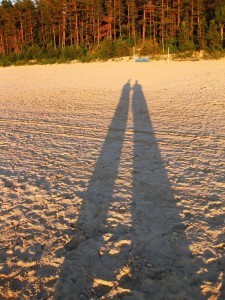Christine Valters Paintner's Blog, page 147
August 19, 2014
Earth Monastery Project – Final reports from the first round!
Abbey of the Arts is delighted to share the results of our first round of grantmaking through the Earth Monastery Project. Last fall we awarded three projects funds to help them serve the community by helping to cultivate an earth-cherishing consciousness.
Rainier Beach Community Garden | Terri Stewart
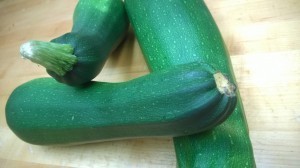 We, the youth and chaplains of the Youth Chaplaincy Coalition, were so excited to receive the grant to build the Rainier Beach Community Garden! We just harvested the biggest zucchinis I have ever seen! And maybe a few too many were planted. But that is okay because they are being passed out to whoever in the community needs them. Additionally, there is an overflowing plot of strawberries that slowly are being nibbled away at—by real people! Not the bunnies.
We, the youth and chaplains of the Youth Chaplaincy Coalition, were so excited to receive the grant to build the Rainier Beach Community Garden! We just harvested the biggest zucchinis I have ever seen! And maybe a few too many were planted. But that is okay because they are being passed out to whoever in the community needs them. Additionally, there is an overflowing plot of strawberries that slowly are being nibbled away at—by real people! Not the bunnies.
After our spring planting, we have completed a fall planting and added four more tons of dirt to our community garden, enabling us to add four more garden boxes. We just planted root vegetables including beets, onions, and vegetables along with some Pacific Northwest staples that grow nearly year round here—green beans and snap peas.
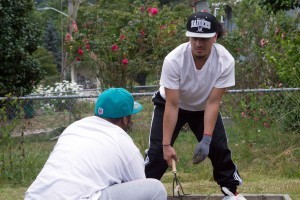 This garden has become a labor of love for our little community. We reached out to the youth at a transitional home (from incarceration to real life) and have been nurturing the garden along with chaplains and mentor volunteers. The youth have grown to appreciate getting their hands into the soil, seeing things grow (although they don’t want to see any more zucchini for now!), and a renewed understanding of the cycles of life and the rhythm of the earth. Plus they got sneak attack mentoring!
This garden has become a labor of love for our little community. We reached out to the youth at a transitional home (from incarceration to real life) and have been nurturing the garden along with chaplains and mentor volunteers. The youth have grown to appreciate getting their hands into the soil, seeing things grow (although they don’t want to see any more zucchini for now!), and a renewed understanding of the cycles of life and the rhythm of the earth. Plus they got sneak attack mentoring!
It is one of my goals to provide incarcerated youth with a sense of the rhythm of the earth and with sustainable mentoring. This project was able to take kids away from the concrete jungles of the inner city and the detention environment and let them thrive with mature mentors who worked hand-in-hand with the youth.
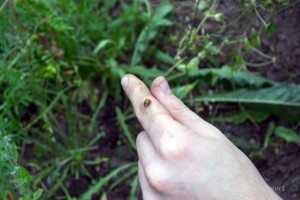 The project and investment from the Earth Monastery Project may be at an end, but this garden will keep on growing—both food and growing youth. True gift.
The project and investment from the Earth Monastery Project may be at an end, but this garden will keep on growing—both food and growing youth. True gift.
My appreciation for your generosity is immeasurable!
Thank you.
Shalom,
Terri Stewart
Prairie Oasis (also known as the Mayfield Monarch Waystation) | Rev. Dr. Martha Brunell
Dear Christine, John, & the Wisdom Council,
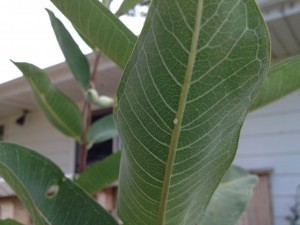 This is the first of several parts of our final report. This report is coming in pieces as a result of weather circumstances and decisions we have made. When our northern Illinois ground was final thawed out and dried in late May following the rigorous winter of the polar vortex and many rainy spring days, we began the physical preparations for our Monarch Waystation. In a more normal winter the plastic would have been laid months earlier. That was impossible this year. Also, we did not want to utilize massive amounts of chemicals on the ground. Instead we chose to cover the huge spiral of ground with heavy black plastic using a slower, more organic method. Four of us were the plastic people checking and refining our design as we went along. We’ve had to learn to work with the wind this summer. Prairie wind is legendary. The amount of materials needed to keep the plastic in place over the months has been incredible. The presence of the plastic throughout the summer has provided congregation members and visitors opportunities to participate in the long waiting time, imagining what it will look like in the fall and in future years. The plastic will be down until the second week in August. When the plastic comes up, the ground will be mulched with a 3-4” layer of mulch. Our initial planting will occur in September.
This is the first of several parts of our final report. This report is coming in pieces as a result of weather circumstances and decisions we have made. When our northern Illinois ground was final thawed out and dried in late May following the rigorous winter of the polar vortex and many rainy spring days, we began the physical preparations for our Monarch Waystation. In a more normal winter the plastic would have been laid months earlier. That was impossible this year. Also, we did not want to utilize massive amounts of chemicals on the ground. Instead we chose to cover the huge spiral of ground with heavy black plastic using a slower, more organic method. Four of us were the plastic people checking and refining our design as we went along. We’ve had to learn to work with the wind this summer. Prairie wind is legendary. The amount of materials needed to keep the plastic in place over the months has been incredible. The presence of the plastic throughout the summer has provided congregation members and visitors opportunities to participate in the long waiting time, imagining what it will look like in the fall and in future years. The plastic will be down until the second week in August. When the plastic comes up, the ground will be mulched with a 3-4” layer of mulch. Our initial planting will occur in September.
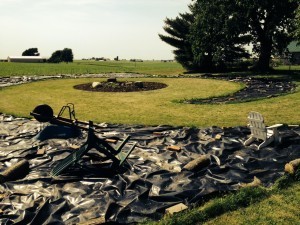 The final July task is the unloading of two wagonloads of donated mulch. This is about half of the mulch we will need. The first mulch arrived on Monday, July 28. Ten of us were involved in the transport and unloading of that mulch. The second load comes tomorrow, and a similar mulching crew will assemble. Already the number of people whose hands are on the Monarch Waystation is growing. The donated mulch is from an area pallet business where one of our members works. When a wooden pallet is worn out, it is recycled as mulch. This particular mulch is treated with a vegetable-based product. Like the decision to use the plastic rather than chemicals, this mulch is another earth-conscious part of our process. Five Monarchs swirled above us in the air at our first mulch unloading. That number is more monarchs than I saw all last summer. We imagined they were keeping track of our progress and reporting in to others that this waystation was really getting started.
The final July task is the unloading of two wagonloads of donated mulch. This is about half of the mulch we will need. The first mulch arrived on Monday, July 28. Ten of us were involved in the transport and unloading of that mulch. The second load comes tomorrow, and a similar mulching crew will assemble. Already the number of people whose hands are on the Monarch Waystation is growing. The donated mulch is from an area pallet business where one of our members works. When a wooden pallet is worn out, it is recycled as mulch. This particular mulch is treated with a vegetable-based product. Like the decision to use the plastic rather than chemicals, this mulch is another earth-conscious part of our process. Five Monarchs swirled above us in the air at our first mulch unloading. That number is more monarchs than I saw all last summer. We imagined they were keeping track of our progress and reporting in to others that this waystation was really getting started.
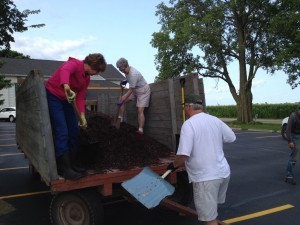 I write two blogs, my personal blog, www.heartlandlistening.wordpress.com, and the pastor’s blog at www.mayfieldchurchucc.org. Over the course of the spring and summer, I have written six blogs on these two sites regarding the Monarch Waystation. They have addressed topics as varied as the eco-justice aspect of the waystation, our experience of spirit in the mighty prairie wind, the act of waiting, the plastic as a teacher of the necessary clearing away that proceeds our new growth, and the waystation as an example of oasis. These are the beginnings of more substantial spiritual and educational work that will undergird future programming at our waystation. Peggy Doty, one of our Team Butterfly members, will be offering a waystation program with the Mayfield Fellowship in August. We are scheduled to host the spring 2015 meeting of forty United Churches of Christ around the Monarch Waystation. By then the waystation should be starting to mature. That program will draw on the Monarchs, Milkweed, Metamorphosis, and Migration interlocking themes I mentioned in the mid-grant report.
I write two blogs, my personal blog, www.heartlandlistening.wordpress.com, and the pastor’s blog at www.mayfieldchurchucc.org. Over the course of the spring and summer, I have written six blogs on these two sites regarding the Monarch Waystation. They have addressed topics as varied as the eco-justice aspect of the waystation, our experience of spirit in the mighty prairie wind, the act of waiting, the plastic as a teacher of the necessary clearing away that proceeds our new growth, and the waystation as an example of oasis. These are the beginnings of more substantial spiritual and educational work that will undergird future programming at our waystation. Peggy Doty, one of our Team Butterfly members, will be offering a waystation program with the Mayfield Fellowship in August. We are scheduled to host the spring 2015 meeting of forty United Churches of Christ around the Monarch Waystation. By then the waystation should be starting to mature. That program will draw on the Monarchs, Milkweed, Metamorphosis, and Migration interlocking themes I mentioned in the mid-grant report.
August will be the time for mulching the waystation and making final decisions about plants and shrubs being donated and purchased for September’s planting. Team Butterfly will determine if there are other financial resources we need for this year and engage in preliminary financial planning for future years’ development and maintenance of our Monarch Waystation. We will send you part two of our final report with pictures and an accounting of how all the grant funds were spent.
In September we will plant. We will also be holding a public dedication of the waystation to which the larger community will be invited. The other important items of conversation for Team Butterfly at this point will be 2015 planting and how we are going to encourage families within our congregation and individuals and groups beyond us throughout the county to establish plots large and small where Monarchs can feed, rest, and lay their eggs. Recently one family left church headed for an area plant nursery. They have already planted milkweed plants in their yard. Part three of our final report will include information from our dedication and our proposed logo for the waystation.
Thomas Berry’s words came my way this week: “The natural world is the larger sacred community to which we belong. To be alienated from this community is to become destitute in all that makes us human. To damage this community is to diminish our own existence.” It is our commitment that the Mayfield Monarch Waystation will be a place for many others to find themselves in “the larger sacred community to which we belong.” This waystation is set on beautifully spacious land that can enlarge us spiritually where we have been diminished. And it will set our hands to the good work of eco-justice, the necessary reminder across creation that we are all in this together.
Thank you for your grant that helped us start this project in 2014 and not a few years from now. Several pictures accompany this first part of our final report. One is a picture of our famous black plastic. Another is a monarch egg on the underside of a milkweed plant close by where the waystation will be. And a third shows mulch unloading.
With gratitude from Mayfield and the Monarchs, Martha
Dance4Peace on Earth | Candice Tritch & Andrew Janssen
The Dance4Peace on Earth film project has concluded — so to speak. For the purposes of the grant, it’s done. But something happened to us along the way. Somewhere between January and June, we found a path that’s leading us on, and we know in our hearts this first film is only the beginning.
The collaborative nature of the project resulted in two things: it produced a series of videos that spread the message of peace through a global dance, and it fostered a sense of empowerment in the hearts of those who were a part of it.
The members may be “ordinary people” in their own towns, but they stepped up in an extraordinary way and are now making a statement to viewers all around the world. Their lives are changed, and their contributions are serving to change the lives of still others, in an ever-widening ripple effect.
Actually, the project had a third result – one we did not predict, but new seems obvious and natural in hindsight. Somewhere between the composition of the soundtrack and the rendering of the final movie six months later, a movement started. People responded to this project in all sorts of ways, and from places we hardly knew existed. Dance Alchemy evolved from a local and regional dance company into a collective of dancers from more than 30 countries, all drawn together in a common vision to dance for peace. Even after we closed submissions for this most recent dance, they continued to join, to write, and to ask what’s next.
We changed, too. Our vision for connecting dancers around the world has expanded to include every country on Earth. Goals that seemed like wild fantasy just six months ago look perfectly rational and achievable to us now. Our friendships with international members have changed our lives forever. Through their eyes, we see into countries and regions previously hidden to us, and understand more than ever the importance of the Dance4Peace onEarth project.
We can’t stop. So we won’t stop.
Already, two more movies are planned, and we are envisioning new and greater expansions every day. Our members are champing at the bit to get going. We started out to create one movie, fashioned around the notion that dancers across the globe might like to connect and dance together for peace. Along the way, we stepped into a whole new life.
Thank you, Christine, John and everyone at Abbey of the Arts, for making this
dream a reality, and nudging us into this wonderful new path.
Love & Peace,
Candice Tritch, Director
Andrew Janssen, Technical Director
Dance Alchemy, Inc.
“We put the Move in Peace Movement!”
You can find out more about the Earth Monastery Project and help support our vision of cultivating an earth-cherishing consciousness and giving small projects a chance to succeed by stopping by this link.
August 18, 2014
St. Francis at the Corner Pub (love note from your online Abbess)
Approaching the door, you can already
hear his generous laughter.
He stands on the bar upside down for a moment
to get a new perspective on things,
a flash of polka-dotted boxers
as his brown robe cascades over his head,
sandaled toes wiggling in the air in time with
a fiddle playing in the corner.
Rain falls heavily in the deepening darkness
and he orders a round of drinks
despite his vow of poverty and the single silver coin
in his pocket, multiplied by the last Guinness poured.
Nothing like a good glass of wine, he gleefully says,
heavy Italian accent echoing through the room,
he holds it up to the overhead light, pausing for a moment
lost in its crimson splendor, breathes deeply.
At ease among fishmongers and plumbers,
widows and college students, and the
single mother sneaking out for a moment
of freedom from colic, cries, and diapers.
As the wind blows rain sideways, in come the
animals, benvenuti to pigeons, squirrels, seagulls, crows,
and the neighborhood cat balding from mange,
a chorus of yowls, coos, caws, and meows arising,
all huddle around him. No one objects to the growing
menagerie, just glad to be dry and warm.
He clinks glasses all around, no one left out.
—Christine Valters Paintner
Dearest monks, artists, and pilgrims,
Above is my latest poem to accompany one of the dancing monk icons. St. Francis has always struck me as one of the most earthy and approachable saints, someone you might run into at a pub and would make you feel like you were old friends.
With so much continued heartbreak in the news, I reflected a long while this week on the value of our inner monk and artist at times like these. It might be tempting to think that our commitment to love and beauty, to slowness and spaciousness, to wonder and presence are luxuries in times of so much violence, so much rending of bodies and spirits.
While none of us can save the world, we can create sanctuaries in our lives, places where compassion is the automatic response rather than fear, where we turn to hope and trust before anxiety, love rather than judgment.
I have no easy answers for the struggles we must face together, other than to know that these practices help to create a sense of presence I would otherwise not be able to hold onto. We might be tempted to think that engaging in contemplative practices will automatically lead to a life of peace, yet we know from the ancient desert mothers and fathers, that the practice is one for a lifetime. We will come up over and over against the inner and outer struggles. We are called to return to the deep heart each time, the place where profound peace is possible.
And community is an essential part of this path as well. I am deeply grateful for this virtual gathering of thousands who show up here and say this matters. Just like those arriving to the pub with St. Francis, you are all welcome here. Know yourself as a part of something much bigger.
If you would like to explore the gifts of the monk and artist paths in more depth, I invite you to consider registering for Way of the Monk, Path of the Artist, a 12-week online journey which begins September 1st. Gather with a small community in our dedicated virtual space to work through my book The Artist's Rule together, guided by two fabulous facilitators.
If you are a young adult considering joining us in Ireland next spring on pilgrimage, please let us know of your commitment by September 17th.
With great and growing love,
Christine
Christine Valters Paintner, PhD, REACE
www.AbbeyoftheArts.com
Icon: Dancing St. Francis by Marcy Hall (order here)
August 6, 2014
Miriam dances for freedom (a love note from your online Abbess)
 Dearest monks, artists, and pilgrims,
Dearest monks, artists, and pilgrims,
I am so excited that we have the next two dancing monk icons ready to view! Marcy Hall completed King David and Prophet Miriam, both described as dancing with joy in the Hebrew Scriptures, and give us a way to honor the Jewish roots of the Christian tradition.
I am moved by both images, but perhaps especially by Miriam in these difficult days where the news feels so relentless with wars being waged all around us, with children dying, with so many struggling to get their most basic needs met.
John and I have been praying our morning lectio divina with the Psalms and the language used there is so honest, sometimes difficult, but always a powerful reminder of the shadows of the human heart and how we project our own need for power onto God. As I sit in prayer each morning, I send out blessings for all those who suffer, and I remember my own struggles and endeavor to sit honestly with the brutal and brutalized parts of myself. Sometimes the best thing we can do in our times of helplessness before the world's sorrow is to look within and commit again to the deep peace we seek as monks in the world.
Miriam moves my heart these days because she is a reminder of the dance ready to break out at every experience of freedom. Every time an external or internal shackle is broken, dance is summoned forth. I love that she carried her tambourine with her in the hurried exit from Egypt. As she glanced around at her things, she knew this would be necessary in the days ahead. She knew there would be reasons for dancing. I am reminder of a powerful poem by Jack Gilbert about how in the midst of the world's madness we must "risk delight." He goes on to write that "there will be music despite everything." The songs of the cosmos continue to ring forth no matter how much we resist.
In these days when the news offers little of solace, see if you might hold your own narrow and judgmental places with compassion, and in that softening see if you might slip slowly from their grip. Notice if that moment of inner Exodus brings the desire to dance, and if you can offer yourself the generous permission to say yes.
With great and growing love,
Christine
Photos: Dancing monk icons by Marcy Hall (order prints here)
August 5, 2014
Next 4 Dancing Monk Icons now available as prints!
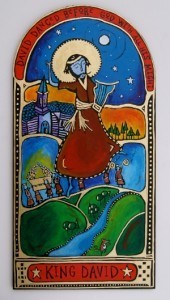 Our wonderful artist-in-residence Marcy Hall, the creativity behind our amazing series of dancing monks, has completed the second four in the series of dancing monks. You can stop by her website to order a beautiful print reproduction of Francis of Assisi, Brendan the Navigator, King David or Prophet Miriam. Please note: orders must be placed by the end of August and shipping will take place at the end of September.
Our wonderful artist-in-residence Marcy Hall, the creativity behind our amazing series of dancing monks, has completed the second four in the series of dancing monks. You can stop by her website to order a beautiful print reproduction of Francis of Assisi, Brendan the Navigator, King David or Prophet Miriam. Please note: orders must be placed by the end of August and shipping will take place at the end of September.
50% of the purchase price goes to support the Earth Monastery Project and the Abbey scholarship fund.
There are four more icons coming in this initial series: Thomas Merton, Rainer Maria Rilke, Dorothy Day, and Amma Syncletica (one of the desert mothers). Marcy hopes to have those completed by early autumn, at which time you will be able to order from all 12 of the series!
July 22, 2014
Embracing a Surplus (a love note from your online Abbess)
Dearest monks, artists, and pilgrims,
I was delighted to receive the image above the other day from fellow dancing monk and artist Karen Newe. The text comes from my book The Artist's Rule, specifically the fourth chapter, which is one of my favorites on the importance of sacred rhythms for creative renewal. Seeing my words appear in such a visually delightful way was a gift.
I have been pondering the gifts of sacred rhythms and my own creative renewal a great deal this summer with time to rest and heal and nourish myself deeply. This is a part of my own annual rhythm, allowing summer to be spacious and unstructured. Last summer my word was "sustainable" as I leaned into how to make this work I love so much sustainable energetically. Even with work that arises out of passion, we bump up against our limits of what we can give and how much renewal we need.
This summer, my word has shifted to one even more generous: surplus. I am not just thinking about how to have enough energy and resources to meet the needs of this flourishing community, but to have more than enough, a surplus, an excess of reserves.
My word is inspired by a quote I read a couple of years ago by Jungian analyst Robert Johnson in his book The Fisher King and the Handless Maiden:
“Nothing happens, which is enough to frighten any modern person. But that kind of nothingness is the accumulation or storing of healing energy. . . to have a store of energy accumulated is to have power in back of one. We live with our psychic energy in modern times much as we do with our money—mortgaged into the next decade. Most modern people are exhausted nearly all the time and never catch up to an equilibrium of energy, let alone have a store of energy behind them. With no energy in store, one cannot meet any new opportunity.”
Those words have stayed with me ever since I read them, because I have recognized the call of the monk in them. What makes this monastic path so counter-cultural is the active resistance against living a life of busyness and exhaustion, of not making that a badge of pride, of having an abundance of time to ponder and live life more slowly and attentively.
How many of us feel our energy is mortgaged into the next decade? How many of us can never catch up with the rest we so desperately need much less feel like we have a "store of energy" behind us?
There are, of course, seasons of life which sometimes demand more from us energetically. It has been two years since John and I embarked on our life pilgrimage which uprooted us from our long-time beloved home in Seattle and sent us to Vienna, Austria for six months and then on to Galway, Ireland. So much moving and transition over time demands a lot of inner resources. In some ways, I feel as if we are finally landing in Ireland, as if my body finally trusts that I am not going to make it uproot and move again for a long while.
I am entering a new season of life, not one marked by so much change and wandering, but one committed to stability for the long season ahead. One where I fall back in love with the sacred ordinary details of daily life: cherishing old and new friendships, shopping at the market and cooking for nourishment, long walks along Galway bay noticing something new each time, showing up to my computer each day to write from my heart.
The wisdom of the seasons is that they invite us to become aware of the cycles of our lives as we move through each day, each year, and ultimately a lifetime.
Seasons remind us that there is a time for each thing, and when the season shifts we do best not resisting, but embrace the new call.
Seasons reflect the deep insight of creation that everything follows a pattern of blossoming, flourishing, releasing, and resting, and we flourish best when we allow the fullness of that rhythm into our lives in a variety of ways.
Being a monk in the world is in part about learning to tend to these inner and outer seasons, and discover in creation a mirror for our own flourishing and resting. Praying the Hours is one way of honoring the ancient rhythm of the day's rise and fall, and so our own inner rise and fall as well, and how they facilitate our creative renewal.
For me, it is a season to right now to rest up for the demands of the work I love so much. It is a season to gather a surplus, a store of energy to meet this work with joy and generosity. And it is a season to root deeply into the earth of this beautiful land which has called us to make our home here.
What is it the season for in your own life?
If these ideas spark your imagination and you want to join with others in exploring the wisdom of your own inner monk and artist, join us for Way of the Monk, Path of the Artist (September 1-November 23, 2014), a 12-week online journey through my bookThe Artist's Rule (chosen as one of the 50 Best Spiritual Books of 2011 by Spirituality & Practice).
Scroll down for more details in this newsletter about upcoming live programs as well including our brand new retreat in the Northwest Coming Home to Your Body: A Women's Contemplative Embodiment Retreat (April 17-21, 2015) where we will tend to ways of discovering a generous surplus within.
We also have just one space left in the October 20-28, 2015 Monk in the World pilgrimage to Ireland, all other 2015 dates are full (email me to be placed on the waiting list). There is still room in our pilgrimage for young adults (20s and 30s) March 18-25, 2015 in beautiful Glendalough and journey with us to Vienna May 23-31, 2015.
We also have two upcoming dates for Awakening the Creative Spirit in the United Kingdom (November 9-14, 2014) and in the Pacific Northwest U.S. (April 26-May 1, 2015). If you are a soul care practitioner wanting to deepen into the creative arts for your own inspiration and to bring these tools into your own practice of ministry, we welcome you to join us for a deep creative dive among kindred souls! These will be the only dates until 2016.
With great and growing love,
Christine
Christine Valters Paintner, PhD, REACE
www.AbbeyoftheArts.com
July 16, 2014
Way of the Monk, Path of the Artist online journey this fall!
A 12-week online class and intimate soul journey in community limited to 20 participants
Details and registration here>>
Would you be nourished by a twelve-week commitment to exploring the place where contemplative practice and creative expression support and nourish each other?
Are you an artist or writer seeking more grounding for your creativity in ancient spiritual traditions?
Do you find yourself drawn to contemplative ways of being including silence, solitude, wonder, and presence?
Do you have a hunger to discover what emerges from being a contemplative artist and a creative monk?
This class is for anyone seeking to make more explicit connections between their spiritual practice and their creative expression. You might consider yourself an artist, a poet, or simply someone who experiences joy in the process of creating. You might consider yourself a contemplative or have experienced a longing for more presence to each moment.
This class is also for those who are looking for an online community – a kind of virtual monastery – to support your creative and contemplative practice.
Our primary text for this class is Christine's book The Artist's Rule: Nurturing Your Creative Soul with Monastic Wisdom. You will need to purchase a copy of the book in addition to your registration. It is not included in the program fee.
The guides and facilitators for this journey will be Cheryl Macpherson and Stacy Wills, both are trained as spiritual directors, and have studied extensively with Christine. They will be present to hold the space as sacred and encourage and support the participants. You will be in wonderful hands.
July 9, 2014
Happy Feast of St. Benedict (a love note from your online Abbess)
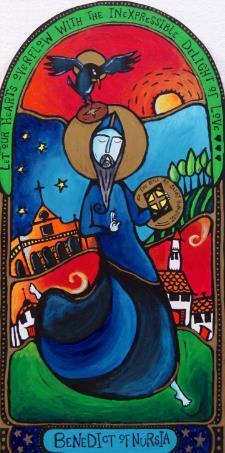 St. Benedict and the Rainstorm
St. Benedict and the Rainstorm
Early February evening.
Benedict and his twin sister Scholastica,
talk for hours about dealing with wayward
monks, childhood memories, regrets, and how they
sometimes steal away to the forest to dance.
The beeswax candle extinguished, she
went to fetch another, dinner plates
pushed aside with drips of grease left from
roast chicken, celebrating this yearly
time together, the extra jug of wine nearly emptied.
He gets up to leave but she protests.
Benedict’s own Rule, requires him
to be back at his monastery overnight.
Perhaps she knew she would die only three days later.
Or maybe the rose-hued glimmer of evening astonished her.
Or this was one of those moments she just wished
would linger on, her brother’s beard shining
silver in the growing moonlight, wanting to
remember the great brown kindness of his eyes,
feeling the rough warmth of his hands in hers.
Her tears rise up,
falling in great splashes,
her weeping calls forth a fierce rainstorm.
Cosmic forces come down on the side of love,
demanding that self-set rules be broken.
I imagine the two of them listening to
the relentless rain beating down around them,
Benedict yielding to the moment, suddenly
seeing the necessity of riverbanks, but also the
widening expanse into the sea.
Perhaps that night they each dreamt that the river
swelled so high it lifted them to the blue bowl of sky,
until the horizon hallowed them.
Until he could see far beyond the stone walls
he had so carefully built.
—Christine Valters Paintner
Dearest monks, artists, and pilgrims,
July 11th is the feast day of St. Benedict. Benedict's impact has carried on through fifteen centuries because of the wisdom and gentleness of his Rule of life, still shaping the life of communities around the world.
And yet, I have always adored this story about him and Scholastica, which appears in his biography written by St. Gregory. His Rule is good and wise and worthy of its endurance, and the story says that we must hold this Rule lightly. It is a guide, not a tyrant, a trellis gently directing the soul's growth, not something so restrictive that life and love cannot flourish. I like to imagine the love shared between these two siblings for the soulfulness of the monk paths they both chose, their support of one another.
Whatever ways we shape our lives through commitment to practice, we are also called to hold it with enough spaciousness to let love have the final say. I think the sharp rise of fundamentalism in the modern world is a desperate attempt to rest in the security of rules. It is so much easier to point to an external authority than to follow the risky path of love. It is not one or the other, the contemplative life demands we hold both in tension.
I have been having an unexpected summer in many ways. My rheumatoid arthritis, which has been well-controlled with medication for years started to flare in my hands, gently at first, and then I awoke on my birthday unable to move my right hand because of the pain. I was incredibly grateful to get in to see the doctor that morning and to address the pain and inflammation right away. I also had a food intolerance test and discovered I am reactive to many things including dairy, wheat, eggs, nuts, and shellfish. Instead of feeling victimized by this turn of events, however, I have actually felt quite galvanized. My summer was already committed to self-care, but now it has taken on even deeper dimensions as I tend to the ways I nourish myself, I have rejoined my swimming pool to yield to the grace of water on my joints and deepened my commitment to my morning yoga practice as a place of being present to what my body needs in this moment. I listen for how to keep this work sustainable in a loving dance with my body's limitations.
One of my favorite definitions of the artist is the one who creates out of the materials given. This is really how we make art from our lives – responding to the truth of what is, rather than how we wish things to be. We can spend our time wishing things were different, or we can respond with great love to the circumstances as they arise.
My main work task this summer was to complete the manuscript for Coming Home to Your Body, a book on contemplative embodiment due to my editor later this summer. I am so grateful to Ave Maria Press for their flexibility in allowing me to turn in a different manuscript on the theme of pilgrimage, which was already close to completion, and extending the other until next year, so allowing me some more freedom to tend to healing. It feels very honoring of the subject matter as well.
Often our expectations of how life should unfold get in the way of meeting things as they actually are. I know this is true for me time and again, so I am savoring this opportunity to meet my life right now with more gentleness and ease. When we meet the unexpected with love, rather than opposition, we open the way for a more soulful path through life. In yielding my resistance I already find great healing. In softening my internal rules about what should happen, I discover such an invitation to grace.
The space opened up for me has also led to some fabulous conversations with many of my Abbey co-conspirators about online retreats for this coming year. I feel incredibly blessed to have such talented monks and artists with whom to collaborate on bringing you meaningful programs. More on that in August! We have some wonderful things in story for you.
To celebrate Benedict's feast day, you might reflect on the practices which nourish and sustain you and honor those as the great riverbanks of your life. And you might ponder your own widening out to the open sea. How might you dance in that delightful tension?
Pilgrimage is a beautiful opportunity to step out of your daily expectations and habits and see the world in new ways. Please join us in Ireland or Austria in 2015, some dates are full or only a couple of spaces left. It is always an amazing experience of joining with kindred souls to explore sacred landscapes.
And if you are a soul care practitioner, please consider joining us for Awakening the Creative Spirit, our 5-day creative soul-dive through the expressive arts. Dates in the U.K. and the U.S. below.
If you are a monk in the world living in Ireland and want to explore gathering with others committed to this way of being, please save Sunday, September 14th for our first coming together in Galway. It will be an afternoon of learning, conversation, meditation, ritual, and gentle creative exploration. Please email Christine to receive more details including meeting location.
With great and growing love,
Christine
Christine Valters Paintner, PhD, REACE
www.AbbeyoftheArts.com
St. Benedict Dancing Monk Icon by Marcy Hall
June 22, 2014
New Self-Study Classes + Solstice/Birthday Gifts for You!
We have some new self-study classes available. Our Soul Care Institute is changing format and so we are making some of the classes which have been a part of that program available to a wider audience.
Register for any one of these by the end of Tuesday, June 24th and also receive a free digital art journal titled Season by the Sea. This was one of the favorites of the series when I had them printed.
Register for two or more and receive Season by the Sea plus a $20 discount coupon good toward any future program (including live retreats).
To claim your gifts register for the class(es) you want by the end of June 24th and then send Christine an email with your request.
Choose from:
Earth as Soul Care Matrix: The Wild Heart of Ministry **
A Midwinter God: Making a Conscious Underworld Journey **
Live it to Give it: Essential Practices of Soul Nourishment and Self-Care (with Kayce Hughlett)**
Exile and Coming Home: An Archetypal Journey through the Scriptures (register now and receive access starting August 1, 2014)
Honoring Saints and Ancestors: Month of Remembrance (now available as a self-study class which you can start at any time)
Register now and start them at any time in the future.
**For these first three classes, you also have the option of adding individual spiritual direction (with Christine) or individual coaching (with Kayce) for an additional fee.
June 21, 2014
Solstice Blessings + How to Be a Pilgrim (a love note from your online Abbess)
To receive this love note straight to your in-box, subscribe here (and also receive gifts!)
Air travel is like
ancient pilgrims walking on their
knees, flight delays and narrow seats
offer their own kind of penance.
You jettison excess baggage,
leaving behind the heavy makeup case,
knowing the rain will
wash you free of artifice.
Books you wanted to carry left too,
no more outside words needed,
then go old beliefs which keep
you taut and twisted inside.
Blistered feet stumble over rocky
fields covered with wildflowers and you
realize this is your life,
full of sharp stones and color.
Red-breasted robins call forth
the song already inside,
a hundred griefs break open under
dark clouds and downpour.
Rise and fall of elation and exhaustion,
the tides a calendar of unfolding,
a bright star rises and you remember
a loved one waiting miles away.
A new hunger is kindled by the sight of
cows nursing calves in a field,
spying a spotted pony, you forget
the weight and seriousness of things.
Salmon swim across the Atlantic,
up the River Corrib’s rapids to the
wide lake, and you wonder if you have
also been called here for death and birth.
This is why we journey:
to retrieve our lost intimacy with the world,
every creature a herald of poems
that sleep in streams and stones.
“Missing you” scrawled on a postcard sent home,
but you don't follow with
"wish you were here."
This is a voyage best made alone.
—Christine Valters Paintner
Dearest monks, artists, and pilgrims,
I wasn't planning on writing to you again so soon, and yet I couldn't let the Solstice go by without a mention as I so love the wisdom of the seasons. Here in Galway last night the sun did not dip below the horizon until after 10 at night and full darkness did not descend for another hour. The golden glow of the sun's light so late in the day was beautiful to behold and a reminder of how far north we live. As someone who loves the quiet of darkness, I am glad that the earth is shifting today and beginning the long slow journey back toward the womb of night.
Of course, in the southern hemisphere, our fellow monks are experiencing quite the opposite as the descent to winter has reached its peak in terms of sun hours lessening, and now the shift is moving toward welcoming in the growing light. It is amazing to think that our planet is experiencing such diverse movements at the same time.
I think of all of these seasonal shifts as a cosmic pilgrimage. The sun's journey across the horizon, her arc over the sky, always shifting and changing and reminding us that the journey is ongoing. Sometimes we might think of pilgrimage as a voyage to a destination, but the ancient monks knew it reflected something much deeper, the always unfolding quality of life.
The solstice also reflects the call to pause in this midst of the journey. It is a threshold, a resting place in the midst of life's ever onward flow, a place to reflect and savor all that has come until that moment. A time to let go of the busyness which sweeps us in its clutches and commit again to a more slow and present way of being where other wisdom can emerge from beneath the productive and logical mind.
I have a great fondness for this time of the summer solstice as my birthday is on Monday, June 23rd and John's is Tuesday on the feast of St. John the Baptist. We are actually born a day apart on the same year, so our birthdays are usually a two-day long celebration of us. 
Even more remarkable is that several years ago in our early travels to Europe together, we discovered that the solstice here is often celebrated on June 24th because of St. John's day, and begins the night before, on the 23rd for an all-night festival. In Latvia, where my father was actually born, it is their biggest national holiday, so the year we turned 40 we made an ancestral pilgrimage there for our birthdays as the whole country celebrated. Many other European countries hold this Christianized tradition as well.
These pilgrimages we made to places like Latvia, Austria, Germany, Belgium, England, and Ireland over the years were all journeys to make ancestral connections. But they also opened up inside of us a deep appreciation for the way that pilgrimage calls us back to ourselves and helps us to "retrieve our lost intimacy with the world" as the poem above says. These journeys help to awaken a new kind of attentiveness to the way the world acts as inner catalyst and calls forth our inner transformation. And even if you make the journey with a loved one, it is ultimately something which calls us to our own solitude and search for inner meaning, our unique gifts to be broken open.
Pilgrimage also leads us to surprising places, to make other journeys we didn't expect. Certainly when John and I began our soulful travels together we didn't imagine ourselves one day living in Ireland and we definitely didn't imagine at the time the grace of welcoming other pilgrims to this place we have now rooted ourselves.
What journeys are calling to you? How might you awaken to the way the world is inviting you deeper into yourself? Can you offer up a holy pause at this threshold time to savor and remember?
Sheila Massey Connor, one of our pilgrims from our May journey has been writing wonderful reflections on her experience at her blog, you can see some of her posts here and here. (Click here for more details on the pilgrimages we offer - spaces available in some of our 2015 dates.)
The next time you hear from me will be in mid-July (July 11th is the Feast of St. Benedict!) when we announce the lineup of online classes for the coming year. We are very excited about what we are dreaming up in the spaciousness of our summertime, plus there will be an opportunity to subscribe to the series of online retreats for a discount and with extra gifts. (Hint: the dancing monk icons will be featured for Advent!)
In celebration of the solstice and our birthdays, we are releasing some new self-study classes below, along with free gifts for registering (now through June 24th)! See below for more details.
And if you live in Ireland, John and I are also holding the possibility of starting some monthly gatherings for monks in the world here, so please email me if you are interested in finding out more.
With great and growing love,
Christine
Christine Valters Paintner, PhD, REACE
www.AbbeyoftheArts.com
Photo by Christine (Christine and John on the beach in Jurmala, Latvia on the eve of St. John's Day)
New Self-Study Classes Available and Solstice / Birthday Sale!
We have some new self-study classes available. Our Soul Care Institute is changing format and so we are making some of the classes which have been a part of that program available to a wider audience.
Register for any one of these by the end of Tuesday, June 24th and also receive a free digital art journal titled Season by the Sea. This was one of the favorites of the series when I had them printed.
Register for two or more and receive Season by the Sea plus a $20 discount coupon good toward any future program (including live retreats).
To claim your gifts register for the class(es) you want by the end of June 24th and then send Christine an email with your request.
Choose from:
Earth as Soul Care Matrix: The Wild Heart of Ministry **
A Midwinter God: Making a Conscious Underworld Journey **
Live it to Give it: Essential Practices of Soul Nourishment and Self-Care (with Kayce Hughlett)**
Exile and Coming Home: An Archetypal Journey through the Scriptures (register now and receive access starting August 1, 2014)
Honoring Saints and Ancestors: Month of Remembrance (now available as a self-study class which you can start at any time)
Register now and start them at any time in the future.
**For these first three classes, you also have the option of adding individual spiritual direction (with Christine) or individual coaching (with Kayce) for an additional fee.
June 16, 2014
Aligning with the Season of My Soul (a love note from your online Abbess)
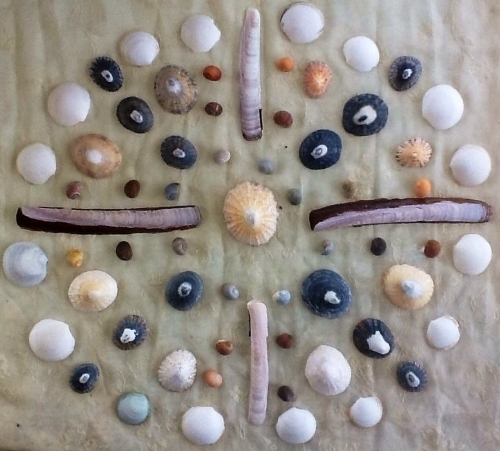
Dearest monks, artists, and pilgrims,
I am relishing the slower rhythms of summer, time for unstructured schedules when I can follow my own inclinations, noticing what my body and spirit need in a given moment. I have much work to do on my manuscript to have it ready by August, but what nourishes the writing process for me is allowing time for diversions like making seashell mandalas, writing poems, and going for long walks when things in my mind need a little shaking loose.
John and I went on a spontaneous trip out to the island of Inisbofin (Island of the White Cow) last week. It is a place we visited last summer and felt smitten with. The requisite monastic ruin on one end close to beautiful beaches with lots of shells for gathering, the other end wild and more rugged with evidence of inhabitants dating back to 8000-4000 B.C. This is an ancient and thin place, revealing the veil to be very diaphanous between worlds.
We went because we have been inspired to create a new pilgrimage itinerary in Ireland for next year, one that is part writing retreat, and focuses on some of the stunning islands off the coast of Connemara. On our overnight trip we felt drawn even more strongly to bring others to that place, and others we have fallen in love with. (You can find out more about Writing on the Wild Edges of the World: A Creative Pilgrimage and Retreat in Ireland - August 30-September 7, 2015 and we have new dates for our Monk in the World Ireland Pilgrimage - October 20-28, 2015).
John and I have returned to our daily practice of lectio divina, after falling away because of so much travel and groups arriving. The beauty of the monastic path is that we are simply called to begin again. To remember that we are always beginners in this spiritual life. And in that return after absence I remember with even more vigor the gifts this practice offers to me.
We are practicing lectio continua, which is rooted in the ancient monastic tradition of choosing a book of the scriptures and praying with a couple of verses each day, working slowly through it. In this way you pray with texts you might not otherwise, you read the words in context. We did this with the Song of Songs, and have recently begun praying through the Psalms, knowing this will be a long-term commitment.
Our text the other morning was Psalm 5:8-9 and the words that shimmered were "make straight the path before me." I resisted at first, because I am not one to seek things laid out in order. I prefer peripatetic wanderings and following the thread. I love meandering and holy pauses, the questions rather than the answers . But as I sat with the text in the silence I realized that it was lifting up a longing I have been having recently: to be in alignment with what is ripening within me.
I am a big believer in seasons of the soul. And of course, moving overseas two years ago and starting new lives on this side of the ocean ushered us into a brand new season. When we moved six months later from Vienna, Austria to Galway, Ireland another new season broke open as we focused on getting to know this landscape that had beckoned us.
In recent months the season has been shifting again, or revealing more of its contours and invitations. I have a deep sense of longing to root myself even further here. I am remembering the delights of the sacred ordinary each day in new and sometimes unexpected ways. And I am being called to spend more energy on bringing groups here who want a soulful and intimate experience of this place we have fallen in love with.
Summer will allow me to keep listening to how this wants to unfold. The season ahead is calling for a deeper alignment, a sense of being in congruence with the movements of the Spirit in my life. This is what the biblical text means for me, a longing to see the new grooves being formed in my soul and follow them. My sense is one of coming into alignment with something deep inside of me that I cannot yet name, but I trust more than anything. There is a rightness in letting go some of what worked before, some of the patterns and rhythms which carried me to this point but are no longer necessary and in fact get in the way of true alignment. This is what living the questions and the mystery means for me.
What would coming into alignment with your own soul's ripening mean for you?
Our rhythm at the Abbey this summer will be much slower, the newsletters will be a little less frequent. We are pausing our weekly invitations to lectio divina, poetry, photography, and dance, as well as the monk in the world guest posts until September again.
With great and growing love,
Christine
Christine Valters Paintner, PhD, REACE
www.AbbeyoftheArts.com
Photo by Christine of seashell mandala
Summer scripture course starts tomorrow!
Our online summer scripture course which John is co-teaching with some amazing colleagues begins tomorrow, so if you want to dive into conversation with others around these sacred texts sign up here. It is going to be a fabulous course and the registration will be closing in the next couple of days, so this is your last chance to join the community.
Join us this fall in the Northeast U.S.
This fall I am delighted to be traveling to the Northeast to teach two different retreats. My dear friend and colleague Kayce Stevens Hughlett and myself will be offering Exploring Archetypal Energies through the Expressive Arts October 1-5, 2015 in Reading, PA with only 1 space left! Kayce has written a guest post for the Abbey on Clues and Curiosity, if you are feeling the nudge to join us stop by to read her reflection (or even if you can't come, I recommend you read her wisdom anyway). My other retreat Sacred Rhythms Writing & Movement Retreat September 20-24, 2014 in Cape May, NJ is officially full but please feel free to contact me if you want to be added to the waiting list.



